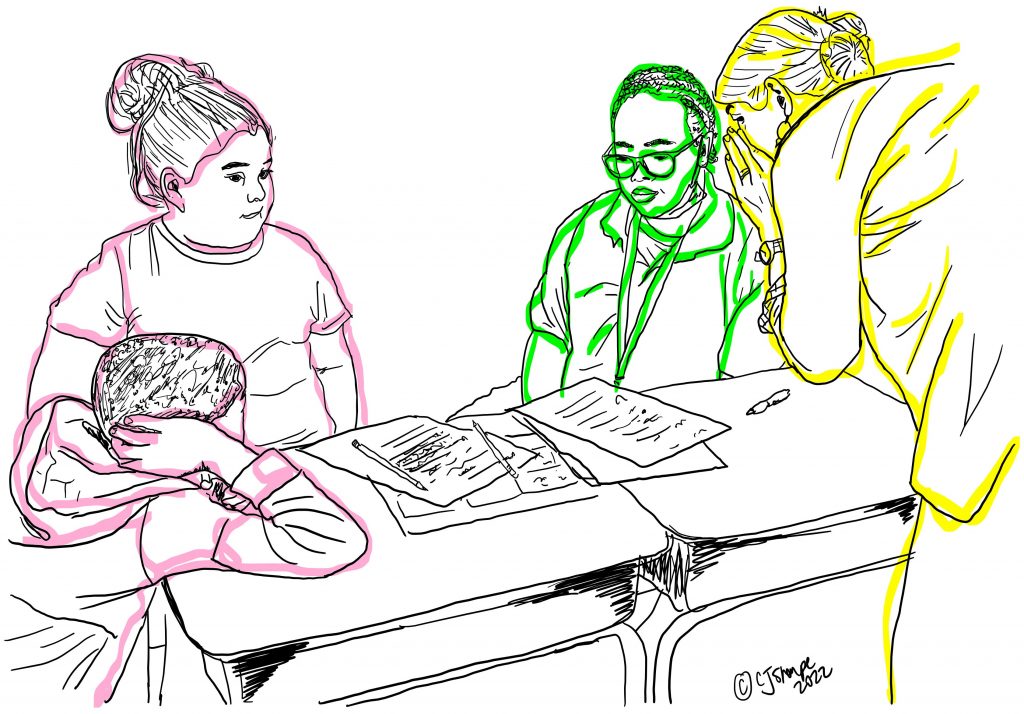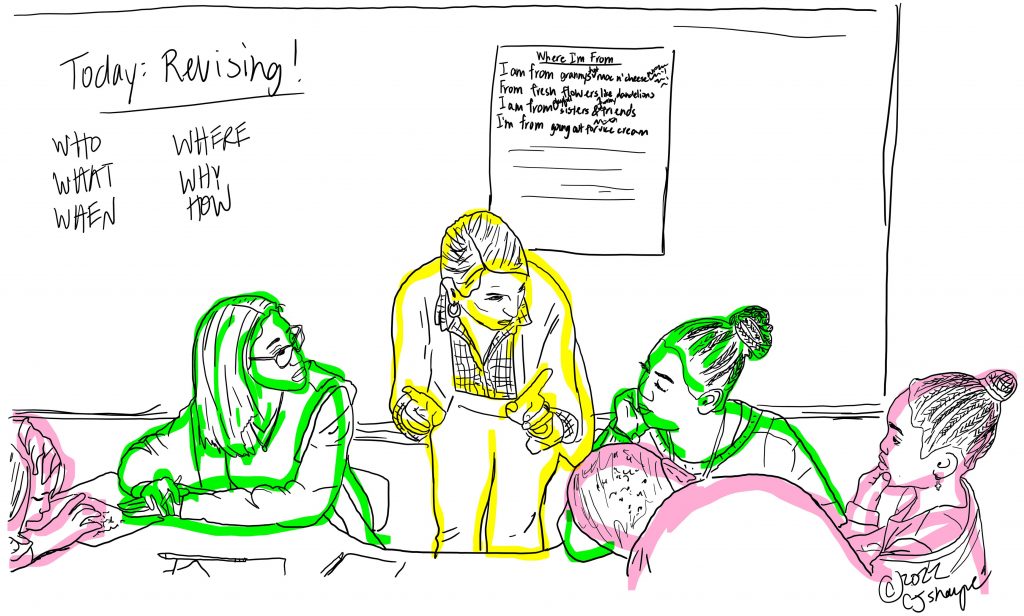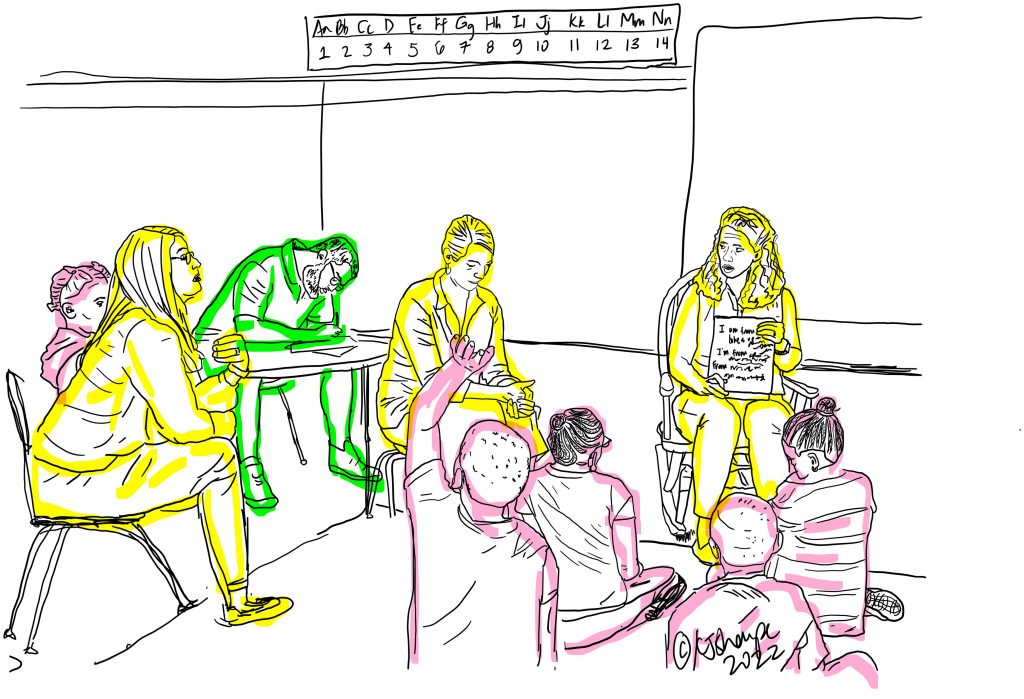One of the design features central to the TTP project is an integration of design principles from critical educator preparation (Lac, 2019) and models for practice-based teacher education (PBTE; Ball & Cohen, 1999; Forzani, 2014). This semester, we focused our 6-week pilot on PBTE models, using a design research approach to plan, act, analyze, and revise our designs. Specifically, we took 8 students from the TTP classroom to a neighboring elementary school, where they worked with 2nd graders in small groups to enact two math Quick Images minilessons, and a series of 3 writing minilessons focused on student poetry. The TTP students had engaged in these lessons first as learners, then rehearsed them in their teaching teams prior to enacting them with students. When possible, these mediated field experiences were followed by collective debriefs focused on student work and instructional next-steps.
In this short post, I use photosketches from inside the 2nd grade classroom to describe the different forms of coaching that happen in mediated field experiences. These practices aren’t new – they’ve been named and studied by many other scholars and teacher educators (e.g., Gibbons & Cobb, 2017; Desimone & Pak, 2017; Gibbons et al., 2021). In each photosketch, coaches are highlighted in yellow, aspiring teachers (high school juniors and seniors from the TTP program) are highlighted in green, and 2nd grade students are highlighted in pink.
Live Modeling
Mediated field experiences (MFEs) often begin or conclude with a short model lesson, usually focused on a content idea, student thinking strategy, or teaching practice that will be a central topic of the debrief.

Teacher time-outs
Teacher time-outs (TTOs; Gibbons et al., 2017) are a “pause button” in practice, which can be pressed by the novices or by a coach. When novices call a TTO, it may be because they’re stumped at how to make sense of student thinking or how to respond to a student’s question. When a coach calls a TTO, it may be because they see a critical moment emerging, and want to give novices opportunity to slow down and think through their choices.

Whispered direction
There are times in MFEs when novices are stuck or stumped, and aren’t sure where to go next…but they just need a quick reminder of what they rehearsed. These moments often feel like someone calling for a line from an off-stage support crewmember during a rehearsal. Unlike a TTO, which may be focused on slowing down and considering options, these whispered directions are simple, quick reminders.

Pacing cues
One subtle but important role of coaches in MFEs is to manage the flow of the minilesson as it unfolds in multiple groups – and to do so without disrupting those minilessons. This usually looks like verbal reminders paired with visual cues about what lesson segment each group should be on, or how much time remains before an important transition.

Fishbowl dual-level modeling
The ‘fishbowl’ structure is widely used and for a range of purposes. In MFEs, we used a fishbowl structure to model writing practices the second grade students would be using, as well as teaching practices the novices would be using to support student writing. This dual-level modeling, with reflective questions posed to the 2nd graders about the writer’s process, provided both students and novice teachers a vision of their work for the day.

This is by no means a definitive list of coaching practices – or even coaching practices that happen during MFEs. But naming these practices and identifying their purposes and forms can help us be strategic about when to use them – or not.
Have you used these or other coaching practices in your work with teachers, pre-service teachers, or aspiring teachers? Drop us a note about your experience(s) in the comments!
-Charlotte
References
Ball, D., & Cohen, D. (1999). Developing practice, developing practitioners: Toward a practice-based theory of professional education. In L. Darling-Hammond & G. Sykes (Eds.), Teaching as the learning profession (pp. 3-32). San Francisco, CA: Jossey-Bass.
Desimone, L. M., & Pak, K. (2017). Instructional coaching as high-quality professional development. Theory into practice, 56(1), 3-12.
Forzani, F. M. (2014). Understanding “Core Practices” and “Practice-Based” Teacher Education: Learning From the Past. Journal of Teacher Education, 65(4), 357–368. https://doi.org/10.1177/0022487114533800
Gibbons, L. K., & Cobb, P. (2016). Content-focused coaching: Five key practices. The Elementary School Journal, 117(2), 237-260.
Gibbons, L. K., Kazemi, E., Hintz, A., & Hartmann, E. (2017). Teacher time out: Educators learning together in and through practice. NCSM Journal of Mathematics Education Leadership, 18(2), 28-46.
Gibbons, L. K., Lewis, R. M., Nieman, H., & Resnick, A. F. (2021). Conceptualizing the work of facilitating practice-embedded teacher learning. Teaching and Teacher Education, 101, 103304.
Lac, V. T. (2019). The critical educators of color pipeline: Leveraging youth research to nurture future critical educators of color. The Urban Review, 51(5), 845-867.